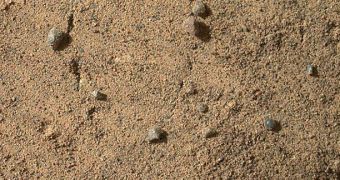NASA's Curiosity rover found chemical particles and signs of possible organic compounds that could allow rudimentary life forms to develop on Mars.
Signs of water, sulfur and chlorine along with carbon-rich chemical compounds have been extracted from the dirt analyzed in Curiosity's on-board laboratory, Space reports.
However, the substances may not have their origins in the Martian surface, but might be part of Curiosity's contamination along its way. Scientists have not reached a conclusion on this yet.
“Even though [Mahaffy's] instrument detected organic compounds, first of all we have to determine whether they're indigenous to Mars,” declared NASA scientist John Grotzinger.
The statement about the new discovery was made by NASA scientists after a few weeks ago they announced Curiosity had found “something for the history books,” without having given any specific details.
The substances were found during Curiosity's observations over “Rocknest” – a hunk of Martian dust and sand found on Glenelg, a rock located at the base of Mount Sharp, in the middle of the massive Gale Crater.
Curiosity cooked the dirt using the small oven inserted in his SAM tool, after which the emanated gases were observed in order to determine their chemical composition.
It has been proven that the material contained a carbon organic compound called chlorinated methane.
“The chlorine is of Martian origin, but it's possible the carbon may be of Earth origin, carried by Curiosity and detected by SAM's high sensitivity design,” NASA representatives declared.
Scientists say that other three NASA rovers – Pathfinder, Spirit and Opportunity – have discovered compounds with an aspect and chemical composition similar to the ones found by Curiosity on Rocknest.
They say they expected to find water molecules attached to sand bits; however, they didn't estimate the amount of water marks on Martian surface would be so high.

 14 DAY TRIAL //
14 DAY TRIAL //